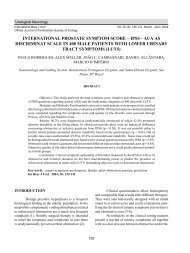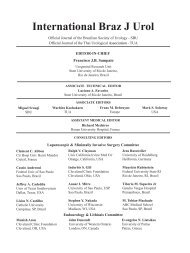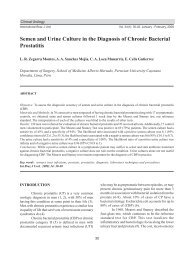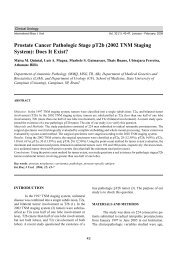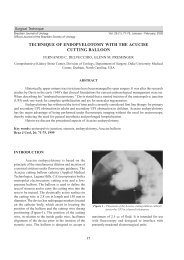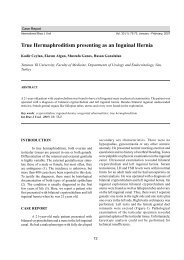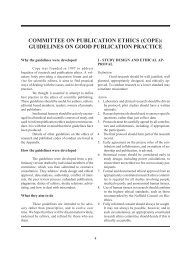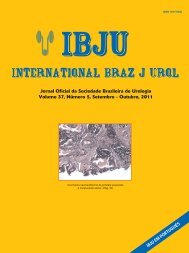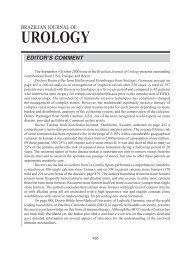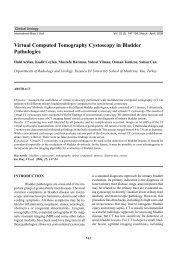Phyllanthus niruri as a Promising Alternative Treatment for ...
Phyllanthus niruri as a Promising Alternative Treatment for ...
Phyllanthus niruri as a Promising Alternative Treatment for ...
You also want an ePaper? Increase the reach of your titles
YUMPU automatically turns print PDFs into web optimized ePapers that Google loves.
<strong>Phyllanthus</strong> <strong>niruri</strong> <strong>as</strong> <strong>Treatment</strong> <strong>for</strong> Nephrolithi<strong>as</strong>is<br />
by an immortalized cell line derived from canine<br />
kidney (MDCK cells) representative of the medullar<br />
collecting duct. This type of inhibitory effect occurred<br />
even when high doses (2.5 to 5-fold the upper limit<br />
in human urine) of CaOx have been employed and<br />
without causing cell toxicity.<br />
EXPERIMENTAL MODELS IN RATS<br />
The effect of <strong>Phyllanthus</strong> <strong>niruri</strong> h<strong>as</strong> also been<br />
evaluated in experimental models of urolithi<strong>as</strong>is in<br />
rats, mainly those induced by implantation of a calcium<br />
oxalate (CaOx) crystal into the bladder (vesical<br />
<strong>for</strong>eign body method). This experimental model of<br />
urolithi<strong>as</strong>is is obtained with no significant metabolic<br />
or systemic alterations and the vesical CaOx seed acts<br />
<strong>as</strong> a supporting surface allowing organic and inorganic<br />
material to precipitate over the central nidus, mimicking<br />
a spontaneous calculus growth. It w<strong>as</strong> initially<br />
shown that rats drinking <strong>Phyllanthus</strong> <strong>niruri</strong> tea ad<br />
libitum, presented decre<strong>as</strong>ed rate of stone growth (33).<br />
These effects occurred independently of any relevant<br />
modification in the urinary excretion of elements<br />
known to promote crystallization and stone <strong>for</strong>mation,<br />
including calcium, oxalate, uric acid, pH, etc. In order<br />
to evaluate if the beneficial effect of <strong>Phyllanthus</strong> <strong>niruri</strong><br />
could be mediated by modifications of the inhibitors<br />
of stone <strong>for</strong>mation, such <strong>as</strong> citrate, magnesium and/or<br />
glycosaminoglycans, Freit<strong>as</strong> et al. (34) administered<br />
1.25 mg/mL/day of <strong>Phyllanthus</strong> <strong>niruri</strong> <strong>for</strong> 42 days in<br />
rats with vesical CaOx seed. This chronic treatment<br />
induced a significant reduction in the calculi growth,<br />
in the absence of any modification in the volume<br />
diuresis or alterations in the urinary concentration of<br />
lithogenic elements including calcium and oxalate.<br />
<strong>Phyllanthus</strong> <strong>niruri</strong> administration did not modify the<br />
urinary excretion of citrate and magnesium, indicating<br />
that the putative antilithogenic effect of <strong>Phyllanthus</strong><br />
<strong>niruri</strong> w<strong>as</strong> not primarily mediated by modifications<br />
in these inhibitors. In contr<strong>as</strong>t, it w<strong>as</strong> observed that<br />
<strong>Phyllanthus</strong> <strong>niruri</strong> induced a decre<strong>as</strong>e in the urinary<br />
excretion of glycosaminoglycans (GAGs) compared<br />
with lithi<strong>as</strong>ic animals receiving water. In contr<strong>as</strong>t, the<br />
content of GAGs w<strong>as</strong> higher in calculi taken from<br />
treated animals suggesting that the inhibitory effect<br />
<strong>Phyllanthus</strong> <strong>niruri</strong> on crystal growth might have been<br />
related to higher incorporation of GAGs into the<br />
calculi. The adsorption of these macromolecules into<br />
the calculi lead to stones with a predominant intracrystalline<br />
amorphous organic matrix. Taken together,<br />
these results suggested that <strong>Phyllanthus</strong> <strong>niruri</strong> w<strong>as</strong><br />
able to prevent the aggregation of calcium oxalate to<br />
the pre-existent crystal without interfering with the<br />
incorporation of GAGs into organic matrix. Although<br />
the underlying mechanism remains to be clarified,<br />
some possible hypotheses can be raised: 1) a neutralization<br />
of negative charges of GAGs reduced the<br />
negative pole <strong>for</strong> progressive deposition of cations; 2)<br />
active components of the plant could have chelated<br />
and/or competed with calcium <strong>for</strong> binding sites on the<br />
crystal surface; 3) effects of <strong>Phyllanthus</strong> <strong>niruri</strong> itself<br />
on other proteins including Tamm-Horsfall protein,<br />
nephrocalcin, osteopontin, prothrombin fragment 1,<br />
etc, modulating crystallization, aggregation and calculi<br />
growth and 4) <strong>Phyllanthus</strong> <strong>niruri</strong> could reduce the<br />
crystal adhesion to the tubular epithelium. Essentially,<br />
these results suggest that <strong>Phyllanthus</strong> <strong>niruri</strong> could<br />
interfere with the calculi growth or prevent stone<br />
<strong>for</strong>mation rather than dissolving pre-<strong>for</strong>med stones.<br />
In order to better mimic what is observed<br />
in clinical practice, Barros et al. (35) using a vesical<br />
<strong>for</strong>eign body model in rats, compared the efficacy of<br />
<strong>Phyllanthus</strong> <strong>niruri</strong> treatment started concomitantly<br />
with CaOx seed implantation with the same treatment<br />
started 30 days after the seed implantation (when the<br />
vesical calculus w<strong>as</strong> completely <strong>for</strong>med). As represented<br />
in Figure-3, the early treatment (Figure-3A)<br />
caused a significant inhibition in the calculi growth<br />
compared with non-treated animals (Figure-3B), <strong>as</strong><br />
previously observed (34). In contr<strong>as</strong>t, the treatment<br />
initiated after the stone <strong>for</strong>mation, did not prevent<br />
the calculi to grow further neither propitiated calculi<br />
elimination; however it induced dr<strong>as</strong>tic changes in<br />
the shape and texture of the pre<strong>for</strong>med calculi (Figure-3C).<br />
Stones taken from <strong>Phyllanthus</strong> <strong>niruri</strong> treated<br />
animals were more homogeneous and contained more<br />
compact surfaces (Figures 3D and 3E) in contr<strong>as</strong>t<br />
to the spicule-shaped surface taken from untreated<br />
animals (Figure-3F). This result suggests that <strong>Phyllanthus</strong><br />
<strong>niruri</strong> probably interferes with the biomineralization<br />
process, by promoting a different interaction<br />
between the crystal and the macromolecules of the<br />
organic matrix. Although <strong>Phyllanthus</strong> <strong>niruri</strong> had not<br />
660



